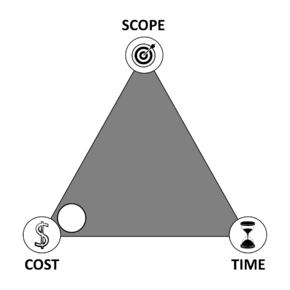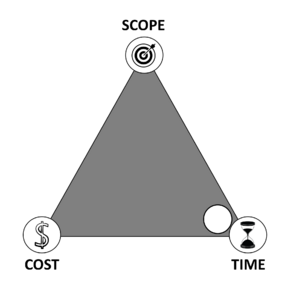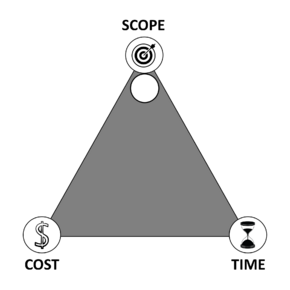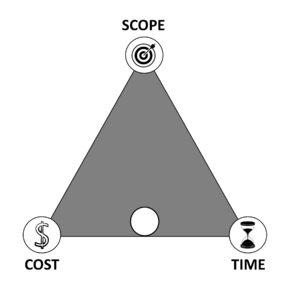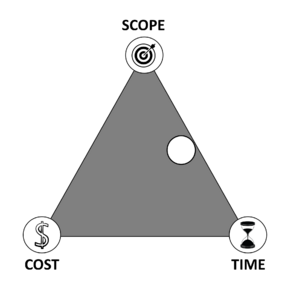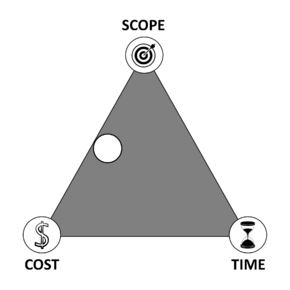Iron Triangle of Project Management
Contents |
Abstract
The roles of a project manager are numerous and one important role is attaining project success by balancing the competing constraints on a project with the resources available [1]. Achieving project success without constraints would be a simple task and all projects would be good, fast, and cheap. Unfortunately, that is not the case as most projects must operate within some important boundaries concerning, scope, time, and cost. The interrelation of these components can make the difference between project success and failure and maintaining a balance between the three factors can help determine the overall quality of a project. The iron triangle is a model of these project elements and emphasizes that a change in one factor invariably affects the others. These changes occur because of the environment that projects operate within, which changes over time. Therefore, projects need a systematic approach to control the issues that may result in a change to the iron triangle constraints.[2]
The theory helps project managers better understand the trade-off dynamics among these main constraints of project management in addition to simplifying the decision-making process [3]. Even though the constraints of the iron triangle are a decent indicator regarding project management success, it is not necessarily the only marker of overall project success. The project scope can be delivered on time and within budget but ultimately result in an unsuccessful project because there are various other factors that help determine the effectiveness of a project.[4] This article will describe the essence of the iron triangle, how project managers can apply the concept in practice, the main limitations of the theory, and annotated bibliography ideas for further reading on the subject.
Big idea
Relation to project management
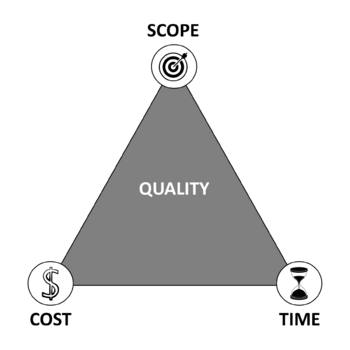
Portfolio, program, and project management all operate in parallel and provide a structured way to align and effectively carry out organizational strategies. However, there is a difference in their focus and contribution to the attainment of strategic objectives and the theory regarding the iron triangle is primarily associated with project management.[6]
Project management is the application of knowledge, skills, tools, and techniques to meet a projects’ requirements. Effective project management consequently helps organizations to increase chances of success and meet business objectives. Poorly managed projects, on the other hand, may result in missed deadlines, cost overruns, and poor quality projects.[1] Utilizing the iron triangle concept can help project managers with these common problems.
The iron triangle (also called the project management triangle) is a concept based on the triple constraints of project management and an important theory in the field. These constraints are limitations placed upon a project within which the project manager and team must operate. There can be various constraints on a project, but there are three essential constraints that operate on most projects. These constraints are scope, time, and cost. An illustration of the iron triangle can be seen in Figure 1.[7]
Essence of the iron triangle
The iron triangle is simply a model illustrating the relationship between these three constraints, showing that no constraint is independent of the others. If any one of them changes, at least one other element will be impacted to restore balance to the project.[8] As seen from Figure 1, the fourth part of the triangle is quality and sits at the center. The quality of the overall project relies on the project scope, cost, and time spent on the project and illustrates that properly balancing the three constraints will impact the quality of your project. There is no universal standard for quality and the definition of it depends on the project. Keeping a project on budget or getting it to market on time are examples of how quality can be measured. Hence, in order to achieve project management success and deliver a quality project, a balance must be realized between the three constraints.[9][7]
The Constraints
Cost
The cost of doing the project is another variable that defines the project. The cost constraint is about the budget that has been allocated for the project which limits the total expense. It includes all financial resources available to complete the project within the prearranged scope. The constraint includes money for the workforce, materials, quality control, and more. Cost is a key factor throughout the project management life cycle and is often set by the client of a project. Therefore, the allocated budget can be fairly close to or far from the actual cost for the project.[7][8]
Time
One of the questions project managers are most frequently asked, is: When will it be finished? The time constraint is closely linked to costs and denotes a specific time frame or deadline within which the project must be completed. This includes milestones and deadlines for each project phase. Completing a project within the given time limit requires proper scheduling and effective time management.[7][2]
Scope
Defines the boundaries of the project and describes what the project must deliver. It includes the processes required to ensure that the project includes all the work required to complete the project successfully. The project scope is therefore about defining and controlling what is included in the project. The term “scope” can refer to either product scope or project scope. Product scope are the features and functions that characterize a product while the project scope is the work performed to deliver a product with some specified features.[1][7]
Constraint flexibility
Initially, most projects have at least one element of the iron triangle fixed in place, i.e. it cannot be changed. For example, the deadline or allocated budget of the project might be non-negotiable. These fixed constraints are often decided by the stakeholder or client of the project but sometimes it's the project manager's to decide.[9] Figures 2, 3, and 4 are illustrations of the iron triangle when one element is fixed which comes at the expense of the other two.
- Illustrations of different scenarios when one element is fixed
The saying "good, fast, or cheap - pick two" is commonly used within project management and represents the scenario where two constraints are prioritized. The terms good, fast, and cheap refer to the three constraints of the iron triangle. The idea is that projects are commonly constrained to choose two of the three constraints and consequently give up the last one. The saying also demonstrates the interdependence of the iron triangle constraints as previously described. [3][7] Figures 5, 6, and 7 depict the scenarios where two elements are prioritized.
- Illustrations of different scenarios when two elements are prioritized
To further explain the concept, let's analyze Figures 6 and 7. In Figure 6, the scope and time are prioritized indicating the client wants the project to be delivered on time and of the highest possible quality regarding scope. To accomplish this, the project cost will rise as a consequence. The client of the project depicted in Figure 6 seems to have ample financial resources as he is willing to spend more on resources to attain the other elements. Figure 7 illustrates a similar circumstance, except the time allocated for the project is unlimited. The project scope and cost constraints should be respected without a specific deadline. The client in this scenario has limited financial resources and will therefore have to be flexible regarding the project schedule.
Trade-off dynamics
The concept behind the iron triangle is essentially about the trade-offs between the three main constraints of project management that form the corners of the triangle. The trade-off dynamics of the constraints are described in Table 1, where the up-arrow (↑) denotes increase and the down-arrow (↓) denotes decrease, for the corresponding constraint.[3]
| Trade-off dynamics | Explanation |
| Scope ↑ ⇒ Time ↑ Cost ↑ | Adding to the scope (e.g. increase the range of a new electric car) of a project will have an effect on time and cost. The engineers will need extra time to find a proper solution and there will be some additional cost because it will take more time and more expensive materials might be needed. |
| Time ↓ ⇒ Scope ↓ Cost ↑ | When the time for a project is limited there will be some consequences to both the project scope and cost. The scope will probably decrease as the deliverables will have to be completed quickly which often results in a final result of lesser quality. The cost will go the opposite way and increase as there will be a need for more labor force to finish the project in time. |
| Cost ↓ ⇒ Scope ↓ Time ↑ | When the cost of a project is scarce the scope and schedule will be affected. The project scope will decrease as the materials used might have to be of lesser quality than preferred. The time needed to complete the project will increase because the labor force will be limited as a result of the scarce cost. |
Application
The big idea behind the iron triangle has now been presented so the question now becomes: How can project managers use this concept in practice? The iron triangle concept is an essential element of a project manager’s toolbox since one of their roles is to balance the scope, time, and cost constraints to deliver the specified output. Projects often incur cost overruns and slippage in real life and the idea behind the iron triangle is critical for project managers to minimize the likelihood of that happening.[5] The iron triangle also simplifies the decision-making process in projects, when problems arise, as later sections will demonstrate.
Managing the constraints
The project manager must manage the constraints of the iron triangle with care to increase the chances of project management success. How project managers can manage the constraints in the planning phase of projects is analyzed in this section along with a discussion of the project manager's roles regarding each constraint.
Time management
The project manager must develop a schedule that can be met by providing time estimates for the duration of tasks and the amount of labor time needed to complete the tasks. Another task regarding time management is to compare time estimations to actual times.[8] The time required to complete a project must be estimated as accurately as possible. This task must be done during the planning phases of the project life cycle to create a schedule that covers the duration of all necessary activities. Some useful project management tools to achieve this are PERT charts and the critical path method.[10]
The PMBOK® Guide divides this into six processes which reflect the project manager's role regarding time:[1]
- Plan Schedule Management
- Define Activities
- Sequence Activities
- Estimate Activity Durations
- Develop Schedule
- Control Schedule
Scope management
Managing the project scope is mainly about defining and controlling what is included in the project [1]. The project manager should define the scope attentively during the planning stage of a project to prevent it from expanding, which might cause the project to fail. This circumstance is known as scope creep in project management and a method for dealing with this is creating a WBS (work breakdown structure).[10]
The PMBOK® Guide divides this into six processes:[1]
- Plan Scope Management
- Collect Requirements
- Define Scope
- Create WBS
- Validate Scope
- Control Scope
Cost management
In the planning phase of a project, the project manager should set up the project budget and map those costs into the project schedule. The project manager should also control the consumption of the budget over the project life cycle.[8] The budget for a project is established early in the project life cycle and project managers often use historic data from similar projects to provide a comparison to base the budget on.[10]
The PMBOK® Guide divides this into four processes which summarize the project manager's responsibilities:[1]
- Plan Cost Management
- Estimate Costs
- Determine Budget
- Control Costs
Controlling the constraints
According to the PMBOK® Guide there are five project management process groups and using the iron triangle is especially relevant for one of them, namely the controlling process group [1]. In the controlling phase of projects, we are dealing with the inevitable changes that can occur in the life of a project. The fact that projects can and will change presents challenges for the project managers and the iron triangle can help to deal with these changes and maintain a balance to the overall project.[5][8]
Possible changes
Examples of changes that can occur in projects which throw the iron triangle out of balance:[5][8]
- Scope related changes
- Additional projects are added to the existing project
- Client calls with a new requirement for a feature
- Market opportunities change
- Cost related changes
- Customer decreases project budget by 15%
- Cost of raw materials increase
- Project requires additional team member
- Time related changes
- Deadline for project is accelerated
- Time-related competition pressures occur
Step-by-step application
When problems arise in a project that forces adjustments to be made, it is important to decide the appropriate actions based on what constraints can be adjusted. The iron triangle helps the project manager to visualize how the problem will affect the constraints and simplifies the decision-making process.[5] The application of the iron triangle in practice is best described with a step-by-step guide: [9].
- Problem emerges in a project which forces a change regarding the constraints of the iron triangle.
⇒ Example problem: Client calls with a new requirement for a feature. - Project manager must locate the problem on the triangle and find out if the problem is time, cost, or scope related.
⇒ The example problem is clearly scope-related as new requirements are being added. - Project manager must figure out which constraints can be changed (are they fixed or not?) to deal with the problem and maintain a balance to the triangle.
⇒ For this theoretical problem, the budget is non-negotiable. Hence, the project manager can only modify the schedule. - Project manager must adjust the flexible constraints to fix the problem and deal with the necessary change.
⇒ In this case, the project manager can only modify the schedule. He decides to push back the project's deadline to a later date. - The iron triangle is now in balance again and the project can be finalized.
Limitations
From the previous sections, it is apparent that the theory behind the iron triangle is useful for project managers when planning and controlling projects and to maintain a balance between the three key constraints of project management. However, the triangle has some flaws regarding how it measures success, relationships between constraints, and the emphasis on cost.
Not a lone indicator of project success
The project management literature tends to measure the success of a project based on the three elements which create the corners of the iron triangle [4]. However, the achievement of these traditional objectives does not necessarily mean that a project is perceived to be successful as this is only one aspect of success and must balance with other factors [11]. The iron triangle takes limited account (depending on the definition of the project scope) of whether the main project deliverable fulfilled the final purpose for which it was intended and whether the objectives of the stakeholders were attained [12].
A project can be late, over budget, and under-deliver on the project scope and still deliver a benefit to users and ultimately be considered a success [4]. A real-life example of this is the construction of the Sydney Opera House. This project was delivered 10 years behind schedule and the budget overruns were severe. The project was obviously considered a major failure, especially when analyzing it from a project management perspective and the iron triangle concept. Today, the Sydney Opera House is a worldwide attraction for millions of tourists per year and considered a major success for Australia. [11] Ultimately, the project should perhaps be considered a success rather than a failure because of the long-term benefits it created.
On the contrary, a project can also be regarded as a project management success and satisfy all the constraints of the iron triangle but still turn out to be a failure in the end. An example of this is the Millennium Dome in London which is the largest single roofed structure in the world. The project was completed on time, within budget, and to scope. From a project management perspective, it might seem like a success, but the building did not create any real value, based on difficulties of finding suitable uses for the building.[11]
Problematic constraint relationship
Another problem with the iron triangle model is regarding the relationships of the constraints. There seems to be a problematic relationship between the cost and time constraints when the model is scrutinized. The cost constraint refers to different types of expenditures, such as people costs, as explained in previous sections. If we take the people costs as an example, it is arrived at by multiplying a cost by duration or time. This means that the cost factor essentially contains time and this can be seen as a problem. Consequently, time can be seen as part of the cost constraint rather than a separate constraint. That leaves us with a model containing only two factors instead of three. [13]
Too much emphasis on cost
There exists another flaw of the iron triangle regarding the emphasis it puts on cost. Despite the fact that there is a strong relationship between cost and efficiency, there is no guarantee that extra expenditure will grant better results. For example, if the project team is incompetent, allocating them extra budget won't necessarily give better results. Also, if the project manager is incompetent and can barely handle managing a staff of five people, then increasing the number of employees will not be beneficial.[14]
Related concepts
This section depicts that the iron triangle might sometimes lack the breadth and depth needed in the complex project landscape. As a result, other more complex versions have been created with added constraints to improve on the triple constraints of the iron triangle.[7]
- In the book Effective Project Management by Wysocki, another version of the iron triangle is mentioned. The version is termed the scope triangle and includes six variables - time, cost, resource availability, scope, quality, and risk. The constraints clearly show that it is closely related to the iron triangle concept. The scope triangle is regarded as a tool for managing complex projects.[8]
- The PRINCE2™ method is another related concept to the iron triangle and builds on the core factors of time, cost, and scope by adding quality (as a separate factor), benefits, and risk resulting in a total of six constraints.[15]
Annotated bibliography
- Wysocki, R. K. (2019). Effective Project Management: Traditional, Agile, Extreme, Hybrid (8th ed.). Wiley.
- This book covers the field of project management and describes traditional project management projects in detail. The iron triangle is mentioned in the book along with in-depth explanations of the triple constraints. It also provides information to get a better understanding of the trade-off dynamics between the constraints. The scope triangle is mentioned in the limitations section and this book is a great reference for those who wish to learn more about the concept that is closely related to the iron triangle.
- Van Wyngaard, C. J., Pretorius, J.H.C.,Pretorius, L. Theory of the Triple Constraint – a Conceptual Review. https://www.academia.edu/8294762/Theory_of_the_Triple_Constraint_a_Conceptual_Review
- This paper explains the triple constraint theory which directly relates to the iron triangle. The constraints and the relationship between them are discussed along with noteworthy illustrations explaining the trade-off dynamics of the constraints. A number of key attributes of the triple constraint model are also discussed in addition to some notable limitations of the iron triangle.
- Bourne, L. (2007). Avoiding the successful failure. Paper presented at PMI® Global Congress 2007—Asia Pacific, Hong Kong, People's Republic of China. Newtown Square, PA: Project Management Institute.
- This paper is about some limitations of the iron triangle concept and demonstrates that delivering value (time, cost, and scope) in a project is only one aspect of success and that projects cannot be judged solely on these constraints. There are some real-life examples of projects mentioned that explain this limitation. The paper is a great read for those who want to learn more about the limitations of the iron triangle concept and what factors (other than time, scope, and cost) should be considered when deciding whether a project is a success or not.
- Siegelaub, J. M. (2007). Six (yes six!) constraints: an enhanced model for project control. Paper presented at PMI® Global Congress 2007—North America, Atlanta, GA. Newtown Square, PA: Project Management Institute.
- This paper explains the theory behind the triple constraint and questions if three constraints are sufficient. In the limitations section of the article, the method PRINCE2™ is mentioned and the content of the paper is mainly about that. PRINCE2™ has six constraints and is termed an enhanced model for project control. This paper is an interesting read for those who want a deeper understanding of this concept that is closely related to the iron triangle concept.
References
- ↑ 1.0 1.1 1.2 1.3 1.4 1.5 1.6 1.7 P.M.I. (2017). A Guide to the Project Management Body of Knowledge (6th ed.). Project Management Institute.
- ↑ 2.0 2.1 Axelos. (2017). Managing Successful Projects with PRINCE2 (2017th ed.). TSO, The Stationery Office.
- ↑ 3.0 3.1 3.2 Van Wyngaard, C. J., Pretorius, J.H.C.,Pretorius, L. Theory of the Triple Constraint – a Conceptual Review. Retrieved February 16, 2021, from https://www.academia.edu/8294762/Theory_of_the_Triple_Constraint_a_Conceptual_Review.
- ↑ 4.0 4.1 4.2 Bannerman, P. L. (2008). Defining project success: a multilevel framework. Paper presented at PMI® Research Conference: Defining the Future of Project Management, Warsaw, Poland. Newtown Square, PA: Project Management Institute.
- ↑ 5.0 5.1 5.2 5.3 5.4 Heagney, J. (2011). Fundamentals of Project Management (4th ed.). AMACOM.
- ↑ The Standard for Program Management (Fourth edition). (2017). Project Management Institute.
- ↑ 7.0 7.1 7.2 7.3 7.4 7.5 7.6 Everitt, J. (2020, May 25). Understanding The Project Management Triangle. Wrike. https://www.wrike.com/blog/understanding-project-management-triangle/
- ↑ 8.0 8.1 8.2 8.3 8.4 8.5 8.6 Wysocki, R. K. (2019). Effective Project Management: Traditional, Agile, Extreme, Hybrid (8th ed.). Wiley.
- ↑ 9.0 9.1 9.2 The Project Triangle. (n.d.-b). Microsoft. Retrieved February 23, 2021, from https://support.microsoft.com/lv-lv/office/the-project-triangle-8c892e06-d761-4d40-8e1f-17b33fdcf810
- ↑ 10.0 10.1 10.2 What Are Constraints in Project Management? (n.d.). Wrike. Retrieved February 15, 2021, from https://www.wrike.com/project-management-guide/faq/what-are-constraints-in-project-management/
- ↑ 11.0 11.1 11.2 Bourne, L. (2007). Avoiding the successful failure. Paper presented at PMI® Global Congress 2007—Asia Pacific, Hong Kong, People's Republic of China. Newtown Square, PA: Project Management Institute.
- ↑ Caccamese, A. & Bragantini, D. (2012). Beyond the iron triangle: year zero. Paper presented at PMI® Global Congress 2012—EMEA, Marsailles, France. Newtown Square, PA: Project Management Institute.
- ↑ Baratta, A. (2006). The triple constraint: a triple illusion. Paper presented at PMI® Global Congress 2006—North America, Seattle, WA. Newtown Square, PA: Project Management Institute.
- ↑ Pastore, M. (2018, August 26). The Iron Triangle is Rusted - Michael Pastore. Medium. https://medium.com/@mwpastore/the-iron-triangle-is-rusted-a6bd7ee5f579
- ↑ Siegelaub, J. M. (2007). Six (yes six!) constraints: an enhanced model for project control. Paper presented at PMI® Global Congress 2007—North America, Atlanta, GA. Newtown Square, PA: Project Management Institute.
